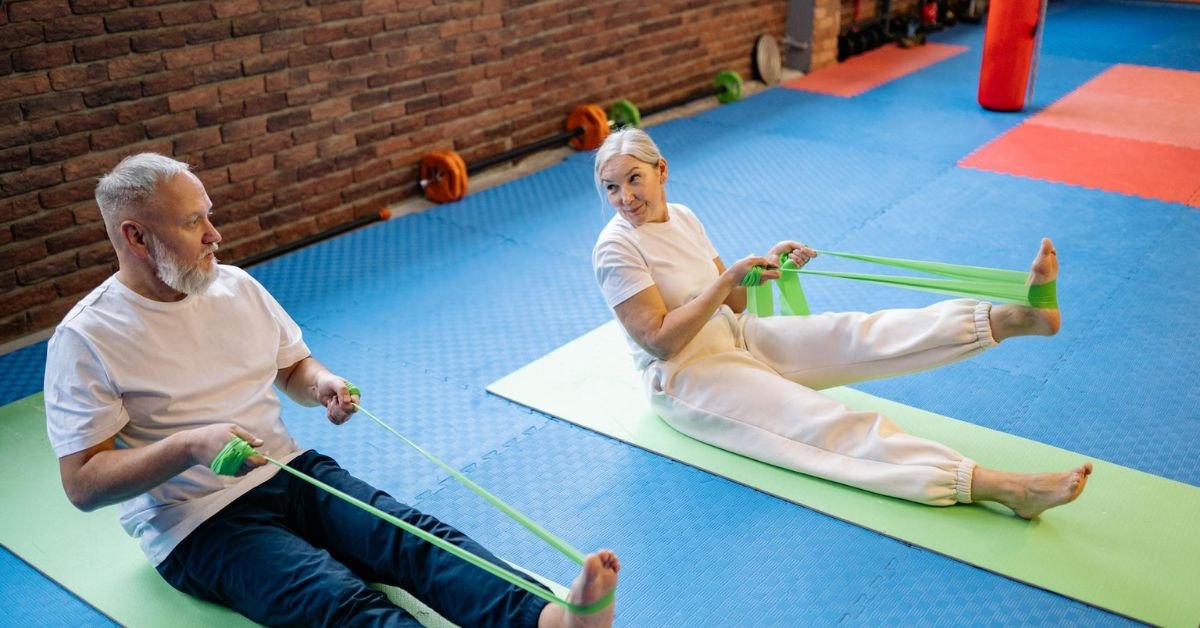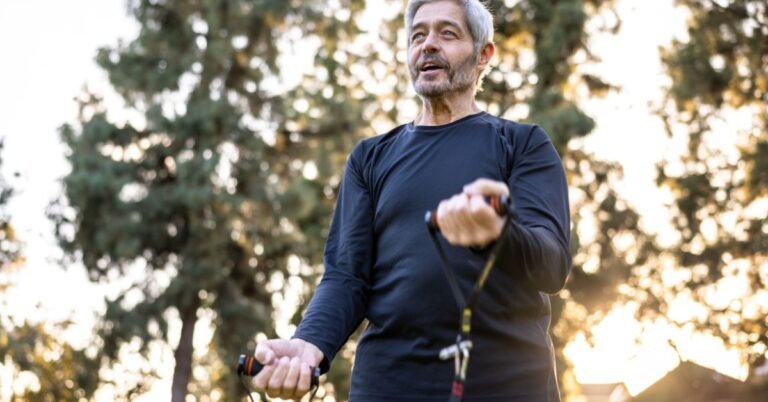It’s well documented on this site and elsewhere that older adults especially should regularly be performing strength training exercises, because of the many benefits to their health and overall lifestyle.
There’s lots of different ways that this can be done whether at the gym or at home, using types of equipment. In this article, we’re going to be exploring how older adults can achieve the recommended strength training frequency and intensity with resistance bands, performed anywhere.
What We’ll Cover:
Strength Training Recommendations For Older Adults
The recommendation from the National Strength and Conditioning Association on strength exercises for older adults is:1
- 2-3 times a week
- 2-3 sets of 1-2 multijoint exercise per major muscle group
- Intensities of 70-85% 1 repetition maximum
To break that down in layman’s terms: older adults should be performing strength training exercises 2-3 times a week. These sessions should include exercises working the major muscle groups, mostly multi joint exercises (meaning the exercise is usually a larger exercise involving moving at two different joints).
The intensity of 70-80% of 1 repetition maximum means the exercise should be challenging; in order to reach this intensity we are aiming for repetition ranges of 8-12 reps per exercise. At the end of the 8-12 reps you need your muscles to feel quite challenged and fatigued, you need to want the rest at the end. You then perform this same exercise for 2-3 sets (meaning 8-12 repetitions, 2-3 times).
Learn more: The Ultimate Guide to Strength Training For Older Adults
The Importance of Progressive Overload
For a beginner, body weight exercises are a great start with strengthening. A chair squat, a wall press up, a lunge, a heel raise for example. You can start out performing these exercises that are working the major muscle groups aiming for that repetition range.
However, once we get stronger and our muscles adapt to these exercises you are likely to find the exercises get a bit easier. You might start to notice you can easily reach 12 repetitions 3 times for a certain body weight exercise. This means you are ready to progress; you are ready for progressive overload.
Progressive overload is an important concept in strength training, it refers to the increasing challenge we need to keep providing our muscles with over time in order to keep progressing. Otherwise our muscles and tissue get used to the stimulus we are providing, and no longer adapt!
There are loads of different options for progressive overload. For example, you could perform an exercise slower, add a pause in, or add a form of weight or resistance. One easy option is resistance bands. Resistance bands are great. They are easily obtainable, cheap and provide a fantastic opportunity to easily add progressive overload to your strength training.
Best Resistance Band Exercises For Older Adults
Here are our recommended best resistance band exercises for older adults:
Banded Row
You can sit down or stand for this one, with the band under both feet. You want to lean forward slightly with a straight back. Hold the band in both hands, you want some tension on before you start. Slowly pull the band back by reaching your elbows behind, you want to feel the movement coming from squeezing your shoulder blades together, then slowly lower the band back down, letting your shoulder blades come apart.
This is working many of the important muscles between our shoulder blades and across our back.
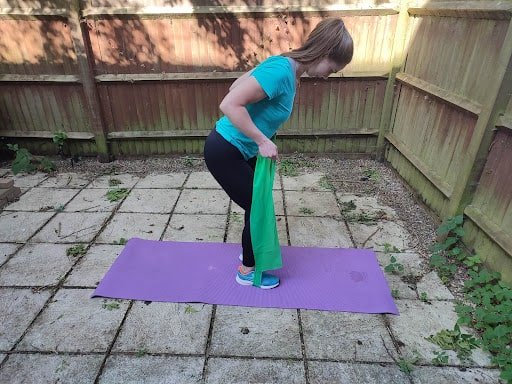
Banded squat
There are different options to add a band in to a squat. A great option to target the gluts (bottom muscles) a bit more is to tie the band and put it around your knees. You perform a normal squat, or a chair squat, with knees pushing out against the band. This increases the muscle engagement of the glut muscles.
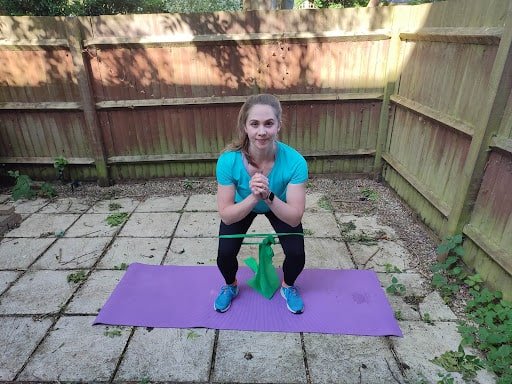
Lateral raise
You can sit or stand for this one, with the band under both feet, holding the band in both hands. You slowly raise the arms out to the side against the resistance of the band, you can have your palms facing forwards or down, then you slowly lower them again. This is working the muscles that sit at the top of the shoulder.
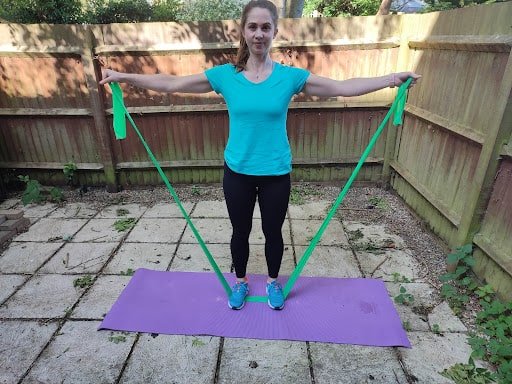
Banded leg press
This is a great way to work the leg muscles. Sit or stand and the put the band around one foot, holding either end in both hands, with a little bit of tension on the band when the knee is bent before you start. You push the leg straight against the tension of the band, then slowly control the motion back to a knee bent position. If you do it standing it is a good challenge for the balance as well. You are working your quads, hamstrings and gluteal muscles here!
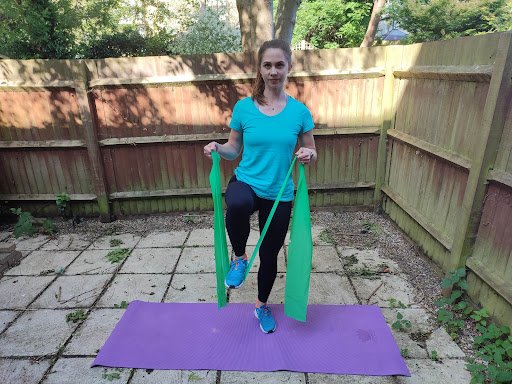
Banded chest press
You can do this sitting or standing. Place the band across the mid-back and hold either end in your hands as you bend your hands in towards your chest, you want a little bit of tension before you start. Then you slowly press the hands forwards away from the chest, then slowly control the motion back again. You are working the major chest muscles here.
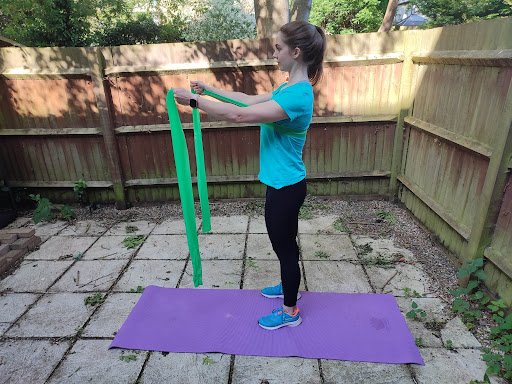
Banded Deadlift
This is a great way to start working on the deadlift movement pattern before trying it with weights. Stand on the band with both feet and hold the band in both hands. You need a good amount of tension on the band. For a deadlift we are aiming to bend at our hips more than our knees, think of sticking your bottom out behind you. We are aiming to keep our backs straight as we hinge at our hips.
Grab low down on the band in the bottom part of the deadlift. Then pull up tall into the deadlift, keeping the band in the hands, and using a feeling of pressing into the ground with the feet and the bottom muscles in order to stand tall. Then control the motion back to the starting position against the resistance of the band, sticking your bottom out and keeping the back straight.

These 6 exercises could form part of full body muscle strengthening workout, recommended to be performed 2-3 times a week. You are working all your major muscle groups with this workout. You would be aiming for 8-12 repetitions 2-3 times each exercise. You can start with slightly less than this if you are beginner and try to work up to it. Once you are easily reaching 12 repetitions, bands are great because you can progress by holding them with more tension! Some packs also come with bands of increasing tension- so you can progress to a tighter band!
Give these exercises a go and let us know what you think in the comments or on social media!
References
- Fragala, Maren S.1; Cadore, Eduardo L.2; Dorgo, Sandor3; Izquierdo, Mikel4; Kraemer, William J.5; Peterson, Mark D.6; Ryan, Eric D.7. Resistance Training for Older Adults: Position Statement From the National Strength and Conditioning Association. Journal of Strength and Conditioning Research 33(8):p 2019-2052, August 2019. | DOI: 10.1519/JSC.0000000000003230

